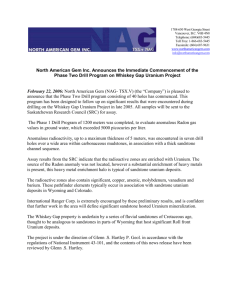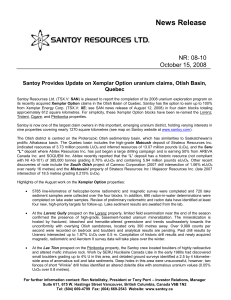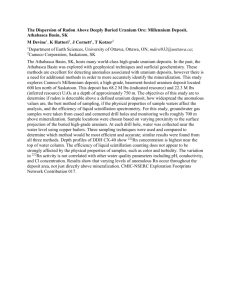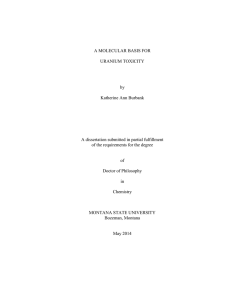Template for Communications for the Journal of the American
advertisement
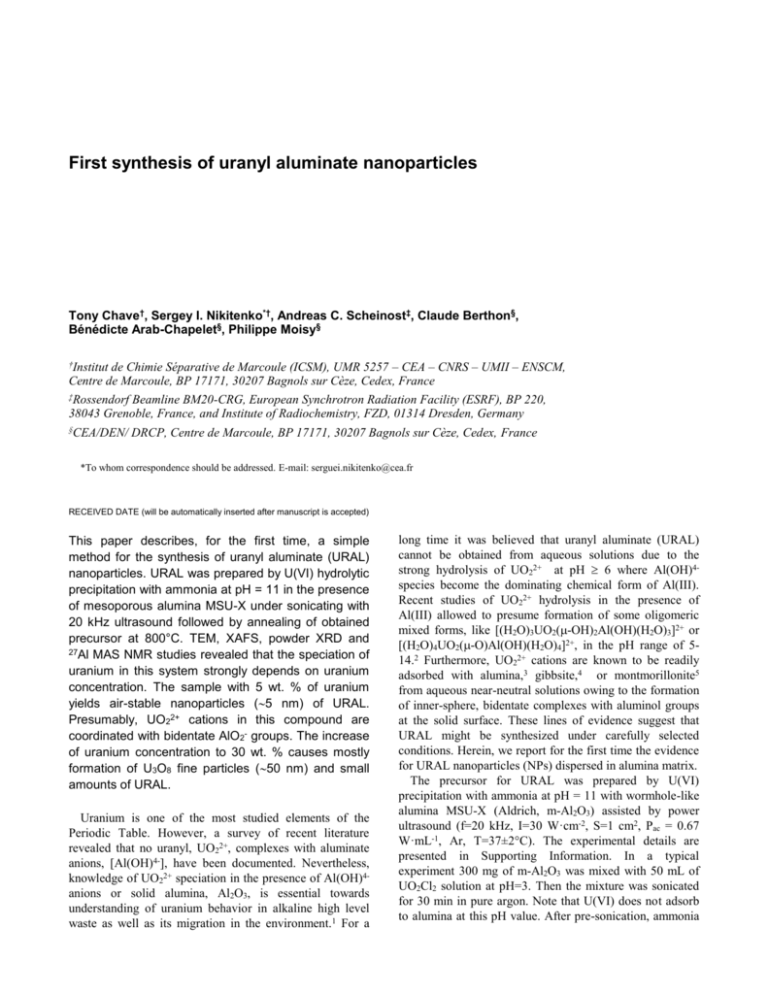
First synthesis of uranyl aluminate nanoparticles Tony Chave†, Sergey I. Nikitenko*†, Andreas C. Scheinost‡, Claude Berthon§, Bénédicte Arab-Chapelet§, Philippe Moisy§ †Institut de Chimie Séparative de Marcoule (ICSM), UMR 5257 – CEA – CNRS – UMII – ENSCM, Centre de Marcoule, BP 17171, 30207 Bagnols sur Cèze, Cedex, France ‡Rossendorf Beamline BM20-CRG, European Synchrotron Radiation Facility (ESRF), BP 220, 38043 Grenoble, France, and Institute of Radiochemistry, FZD, 01314 Dresden, Germany §CEA/DEN/ DRCP, Centre de Marcoule, BP 17171, 30207 Bagnols sur Cèze, Cedex, France *To whom correspondence should be addressed. E-mail: serguei.nikitenko@cea.fr RECEIVED DATE (will be automatically inserted after manuscript is accepted) This paper describes, for the first time, a simple method for the synthesis of uranyl aluminate (URAL) nanoparticles. URAL was prepared by U(VI) hydrolytic precipitation with ammonia at pH = 11 in the presence of mesoporous alumina MSU-X under sonicating with 20 kHz ultrasound followed by annealing of obtained precursor at 800°C. TEM, XAFS, powder XRD and 27Al MAS NMR studies revealed that the speciation of uranium in this system strongly depends on uranium concentration. The sample with 5 wt. % of uranium yields air-stable nanoparticles (5 nm) of URAL. Presumably, UO22+ cations in this compound are coordinated with bidentate AlO2- groups. The increase of uranium concentration to 30 wt. % causes mostly formation of U3O8 fine particles (50 nm) and small amounts of URAL. Uranium is one of the most studied elements of the Periodic Table. However, a survey of recent literature revealed that no uranyl, UO22+, complexes with aluminate anions, [Al(OH)4-], have been documented. Nevertheless, knowledge of UO22+ speciation in the presence of Al(OH)4anions or solid alumina, Al2O3, is essential towards understanding of uranium behavior in alkaline high level waste as well as its migration in the environment.1 For a long time it was believed that uranyl aluminate (URAL) cannot be obtained from aqueous solutions due to the strong hydrolysis of UO22+ at pH 6 where Al(OH)4species become the dominating chemical form of Al(III). Recent studies of UO22+ hydrolysis in the presence of Al(III) allowed to presume formation of some oligomeric mixed forms, like [(H2O)3UO2(-OH)2Al(OH)(H2O)3]2+ or [(H2O)4UO2(-O)Al(OH)(H2O)4]2+, in the pH range of 514.2 Furthermore, UO22+ cations are known to be readily adsorbed with alumina,3 gibbsite,4 or montmorillonite5 from aqueous near-neutral solutions owing to the formation of inner-sphere, bidentate complexes with aluminol groups at the solid surface. These lines of evidence suggest that URAL might be synthesized under carefully selected conditions. Herein, we report for the first time the evidence for URAL nanoparticles (NPs) dispersed in alumina matrix. The precursor for URAL was prepared by U(VI) precipitation with ammonia at pH = 11 with wormhole-like alumina MSU-X (Aldrich, m-Al2O3) assisted by power ultrasound (f=20 kHz, I=30 W·cm-2, S=1 cm2, Pac = 0.67 W·mL-1, Ar, T=37±2°C). The experimental details are presented in Supporting Information. In a typical experiment 300 mg of m-Al2O3 was mixed with 50 mL of UO2Cl2 solution at pH=3. Then the mixture was sonicated for 30 min in pure argon. Note that U(VI) does not adsorb to alumina at this pH value. After pre-sonication, ammonia Note, however, that the pattern of the 30 % U sample contains some of the features of the 5 % U sample (e.g. the peak at 27.5 2θ degree) (Fig. 2c). The XAFS results are in a good agreement with the powder XRD data. The edge position, white line position, and the U=O multiple scattering feature in XANES spectra of heated samples with low uranium content (Fig. S2 Supporting Information) show unequivocally the presence of UO22+ groups. The U LIII-edge k3 weighted EXAFS spectra and corresponding Fourier transforms (FT) are shown in Fig. 3. A Fourier Transform Magnitude B χ(k)k3 solution was added rapidly until pH=11, and the ultrasonic treatment was continued for 1h. Finally, solids were centrifuged, washed until neutral pH with pure water, dried at 75°C and annealed at 800°C (5°C·min-1) for 5 h in the presence of air. We found that the speciation of uranium in the annealed samples strongly depends on uranium concentration. The sample with 5 wt. % of U yields an orange, air-stable product. Low resolution TEM image of this sample (Fig. 1a) shows uranium NPs with an average size of about 5 nm dispersed in alumina matrix. The initial wormhole-like structure of m-Al2O3 (Fig. S1 Supporting Information) is collapsed after the ultrasound treatment similar to sonolysis of m-Al2O3 without uranium.6 The increase of uranium content until 30 wt. % causes formation of bigger, cubicshaped uranium particles after annealing (Fig. 1b). Note that in this case the samples have a deep green-black colour typical for U3O8 oxide. U5% dried at 75°C U5% annealed at 800°C U30% annealed at 800°C U3O8 3 4 5 6 7 k(Å-1) 8 9 10 0 2 4 6 8 R (Å) B A Figure 3. U LIII-edge k3 weighted EXAFS spectra (A) and the corresponding Fourier transforms (B) uncorrected for phase shift of asprepared and heated samples in comparison with U3O8 spectrum. Figure 1. Low resolution TEM images of the samples heated at 800°C A: 5 wt. % U, B: 30 wt. % U. Powder XRD patterns of the precursor compound precipitated at room temperature (Fig. 2a) exhibit the broad peaks typical for m-Al2O3 and γ-AlO(OH) with low crystallinity. The lack of peaks associated with uranium compounds indicates the amorphous state of uranyl hydroxo-compounds precipitated at these conditions. The sample with 5% U heated at 800°C shows XRD patterns of δ-Al2O3 and another crystalline phase presumably related to uranium (Fig. 2b). Search in the JCPDF powder XRD database (Eva version 7.0) did not yield a match, suggesting formation of a new uranium compound. In contrast to the sample with 30 %, no U3O8 oxide was found. 30%U annealed at 800°C 5%U annealed at 800°C Intensity (a.u.) 5%U dried at 75°C * * * 20 ▼ ▼ 30 *▼ ▼ * 40 * * 50 c ▼ b a * 60 70 80 2θ (degree) Figure 2. XRD patterns of freshly prepared and of heated samples (Cu K radiation). (▼) δ-Al2O3; (*) URAL, () U3O8, () peak originated from the stainless steel of the sample holder. Acquisition time was 2 h for 5%U 25°C and 30%U 800°C samples and 6 h for 5%U 800°C sample. The FT EXAFS spectra of as-prepared and heated 5%U samples are dominated by the strong backscattering peak from the axial oxygen atoms of uranyl groups at about 1.8 Å, and from the equatorial oxygen atoms at about 2.2-2.5Å. However, some differences show up at higher distances, most clearly visible in the EXAFS spectra at 6.5-8.5 Å-1. The sample obtained dried at 75°C shows the triplet feature typical for UO22+ tricarbonato complexes7 suggesting that a similar complex formed during alkaline precipitation along with UO22+ hydroxo species. The FTIR spectrum of the airdried sample (not shown here) exhibits strong broad vibrational modes of adsorbed carbon dioxide centred at 1648 cm-1 (2OCO), 1438 cm-1 (3OCO) and 1231 cm-1 (δ4COH)8 confirming the possibility of U(VI) carbonate complex formation at the alumina surface. The FT EXAFS spectrum also indicates a U-U distance of 3.85 Å which is typical for schoepite, UO2(OH)2·H2O.9 Heating this sample at 800°C causes a strong weakening of both the tricarbonate and the hydroxide features. The absence of the U-U peak in FT EXAFS at the distance around 3.8-4.0 Å is in line with the XRD data, confirming that uranium oxide does not form at these conditions. The fit of this spectrum gives 1.9 Oax at a distance of 1.81 Å, a split Oeq1 shell with 2.5 O at 2.36 Å and Oeq2 2.2 O at 2.49 Å, and 0.9 Al atom at 3.35 Å. The Al backscattering peak coincides with the U-Oax multiple scattering peak. Table 1 shows that the local structure of URAL compound is very similar to inner-sphere, bidentate complexes formed by uranyl ions during adsorption at the alumina surface.3 However, the TEM images and the diffraction patterns clearly point to the formation of an individual uranium nanocrystalline phase in our experiments. Most probably, the UO22+ cations in URAL are coordinated to AlO2- groups in a bidentate fashion. Table 1. EXAFS best least-squares fitting results for nanosized URAL and UO22+ complex adsorbed on alumina. Sample URAL 5%U 800°C [Al(O)2UO2]3 Sorption complex at γ-Al2O3 pH = 6.5 Shell U-Oax Na 1.9 R(Å)b 1.81 σ2(Å) 0.0022 U-Oeq1 U-Oeq2 U-Al U-Oax U-Oeq1 U-Oeq2 U-Ald 2.5 2.2 1.9 2.00 2.64 3.13 1.6 2.36 2.49 3.35 1.81 2.32 2.47 3.38 0.0050c 0.0050c 0.0050c 0.0018 0.0074 0.0050 0.0030c a Errors in coordination numbers N are ±25%; b Errors in distances R are ±0.02 Å; c Value of Debye-Waller factor fixed during the fit. d UO22+ complex adsorbed at gibbsite (pH = 5.6).4 The EXAFS spectrum of the sample with 30% U before annealing is similar to that with 5% U (not shown here). Heating this sample to 800°C leads to the appearance of a strong U-U signal at 3.81 Å in FT EXAFS spectrum, similar to that in U3O8. In the XANES spectrum, the white line peak shifts to higher energy, and the U=O multiple scattering feature disappears, suggesting a loss of the uranyl structure. Further evidence comes from the U-O peak in the FT EXAFS, which shows only one maximum intermediate in position to U-Oax and U-Oeq shells. Taking into account the XRD data the latter observation can be explained by superposition of the dominating U-O signal from U3O8 oxide and a residual U=O signal from the uranyl group of URAL. Solid state NMR provides additional evidence for URAL formation. The 27Al MAS NMR spectra of m-Al2O3 heated at 800°C (Fig. S3 Supporting Information) exhibit two major peaks assigned to octahedral and tetrahedral local environment of aluminum, and a relatively small shoulder of pentagonal aluminum sites. After precipitation of 5% U and annealing at 800°C, the ratio between pentagonal and tetrahedral site occupancy increases. It was reported that a pentagonal coordination of aluminum is typical for boehmite-like forms of alumina, AlO(OH).10 Consequently, the increase of pentagonal occupancy could be assigned to UO22+ cations coordinated to AlO2- anions. Note that the lack of noticeable 27Al isotropic shift displacement in the presence of 5% U is in line with the EXAFS data, revealing that only the diamagnetic UO22+ cation is present. The strong effect of uranium concentration on its speciation can be interpreted in terms of solid-state reaction kinetics as illustrated in Fig. S4 (Supporting Information). The observed rate constant of URAL formation, kURAL, would depend on the diffusion coefficients of uranium and aluminium species, DU and DAl, and the interface SU/Al. By contrast, the observed rate constant for U3O8 formation is limited by inner-diffusion of uranyl species in the volume of the uranium precursor, DU1 and DU2. At 5% U content, the surface-to-volume ratio of finely divided uranium particles, S/V, is much higher than that for the bigger uranium particles for 30% U sample. Consequently, at low uranium concentration formation of URAL is favoured over U3O8 formation. The proposed mechanism allows to understand the influence of ultrasound on the URAL formation process. First of all, ultrasonic treatment provides the highest degree of uranium and alumina homogenisation during the hydrolytic precipitation of the precursor phase. Furthermore, mesoporous alumina is known to be transformed to the chemically more active boehmite, AlO(OH), under the effect of power ultrasound in alkaline solutions.6 It is noteworthy that sufficiently pure URAL nanoparticles cannot be obtained under mechanical stirring even at 5% of uranium. The FT EXAFS presented in Supporting Information (Fig. S5) of annealed sample exhibits a signal which could be related to uranyl U=O bonds, but shows also a strong U-U peak of uranium oxide, suggesting a mixture of uranium species. In conclusion, we report here the synthesis of uranyl aluminate NPs. EXAFS spectra of this compound presume that UO22+ cations are coordinated to bidentate aluminate groups. However, further work is needed to establish the detailed structure of this compound. We expect this work to provide new insights into the fabrication of unusual nanosized compounds of 5f-transition metals which are still poorly studied compared to NPs of d-transition elements. Acknowledgement. This work was supported by European ACTINET network and French National GNR PARIS program. The authors acknowledge H. Funke and A. Rossberg for the help in XAFS studies and J. Lai-KeeHim for TEM measurements. Supporting Information Available: Experimental details, additional TEM and XAFS measurements, sketch of URAL formation process. References (1) Zachara, J. M.; Davis, J. A. ; Liu, C. ; McKinley, J. P. ; Qafoku, N. P.; Wellman, D.M.; Yabusaki, S.B. Uranium Geochemistry in Vadose Zone and Aquifer Sediments from the 300 Area Uranium Plume; PNNL-15121; Pacific Northwest National Laboratory: Richland, WA, 2005. (2) Yusov, A.B.; Budantseva, N.A.; Fedoseev, A. M.; Astafurova, L. N. Russ. J. Coord. Chem. 2001, 27, 776-782. (3) Sylwester, E.R.; Hudson, E.A.; Allen, P.G. Geochim. Cosmochim. Acta 2000, 64, 2431-2438. (4) Hattori, T.; Saito, T.; Ishida, K.; Scheinost, A. C.; Tsuneda, T.; Nagasaki, S.; Tanaka, S. Geochim. Cosmochim. Acta 2009, 73, 5975-5988. (5) Hennig, C.; Reich, T.; Dähn, Scheidegger, A. M. Radiochim. Acta 2002, 90, 653-657. (6) Chave, T.; Nikitenko, S. I.; Granier, D.; Zemb, T. Ultrasonics Sonochemistry 2009, 16, 481-487. (7) Rossberg, A.; Ulrich, K.-U.; Weiss, S.; Tsushima, S.; Hiemsta, T.; Scheinost, A.C. Environ. Sci. Technol. 2009, 43, 14001406. (8) Baltrusaitis, J.; Jensen, J. H.; Grassian, V. H. J. Phys. Chem. B 2006, 110, 12005-12016. (9) Allen, P.G.; Shuh, D.K.; Bucher, J.J.; Edelstein, N.M.; Palmer, C. E. A.; Silva, R.J.; Nguyen, S.N.; Marquez, L.N.; Hudson, E.A. Radiochim. Acta 1996, 75, 47-58. (10) Wang, J. A.; Bokhimi, X.; Morales, A.; Novaro, O.; Lopez, T.; Gomez, R. J. Phys. Chem. B 1999, 103, 299-303. Fourier Transform Magnitude SYNOPSIS U5% dried at 75°C U5% annealed at 800°C U30% annealed at 800°C U3O8 0 1 2 3 4 5 6 7 8 R (Å) Uranyl aluminate nanoparticles have been prepared for the first time using ultrasonically assisted hydrolysis of U(VI) in the presence of mesoporous alumina followed by annealing at 800°C.





